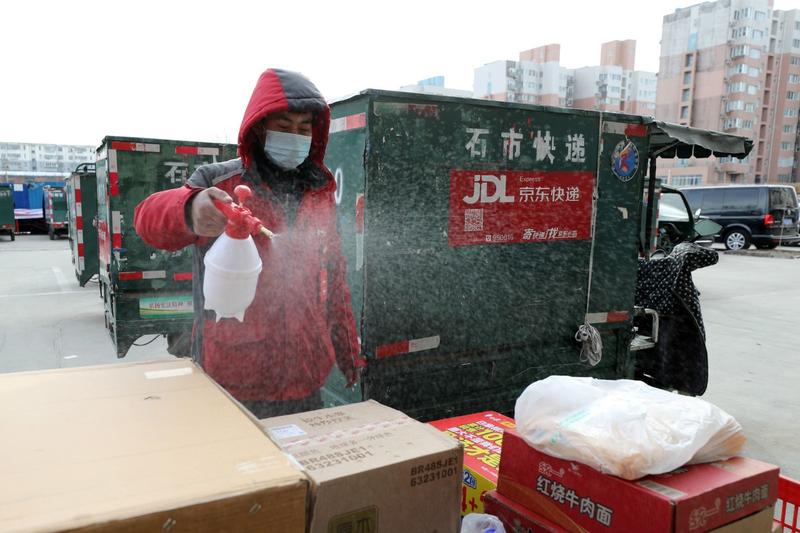 A courier disinfects parcels before delivering them in Shijiazhuang, Hebei province, on Sunday. (WANG ZHUANGFEI / CHINA DAILY)
A courier disinfects parcels before delivering them in Shijiazhuang, Hebei province, on Sunday. (WANG ZHUANGFEI / CHINA DAILY)
Experts estimate that patient zero, the first patient in the Hebei province coronavirus outbreak recently, would have been infected before Dec 15, based on gene sequencing and an epidemiological survey.
"The risk of further spreading (the virus) still exists, and the work to trace its origins are underway," Shi Jian, head of the Hebei Provincial Center for Disease Control and Prevention's emergency management office, said on Sunday, adding that the outbreak still hasn't reached a peak.
Genetic sequencing of the virus found in confirmed cases in Shijiazhuang and Xingtai cities in Hebei also showed the coronavirus strain is a European one and is not related to the recent domestic outbreaks
Genetic sequencing of the virus found in confirmed cases in Shijiazhuang and Xingtai cities in Hebei also showed the coronavirus strain is a European one and is not related to the recent domestic outbreaks, Shi said. He added that the Hebei virus was not a variant of those discovered in the United Kingdom or South Africa.
Hebei has seen infections rise in recent days, with 40 new confirmed cases and six asymptomatic carriers as of 10 am Sunday. The total number of confirmed cases in Hebei stands at 223 and asymptomatic carriers at 161, data from the provincial government showed.
According to Shi, as of 2 pm Saturday, 119 people who had close contact or secondary contact with confirmed cases in Hebei have been located in 20 provinces. Their COVID-19 tests were all negative.
READ MORE: Hebei sees 40 new virus cases, adds 4 medium-risk areas
Both the provincial capital of Shijiazhuang and Xingtai, where all the cases have been found, were placed in lockdown last week to contain the virus spread. Members of the public have also been barred from making unnecessary trips.
However, couriers and other delivery personnel in Shijiazhuang were allowed to resume work on Sunday after their test results were negative. Authorities have put a number of measures in place to ensure residents' daily needs are met.
Over 25,000 delivery personnel have completed a second round of nucleic acid testing, said Ma Yujun, acting mayor of Shijiazhuang.
Zhao Qi, head of a logistics station in Shijiazhuang's Xinhua district, said most of his delivery workers had returned to their jobs after finishing two rounds of testing.
To further contain the spread, Nangong city in Xingtai has begun a second round of mass nucleic acid testing
Li Qing, one of the deliverymen, said he was a bit worried when he was told to stop working and quarantine at home late on Tuesday.
ALSO READ: 46 local virus cases in Hebei among 69 new on mainland
"But now I am relieved, because our jobs are in urgent demand during the lockdown, " Li said.
Lyu Yue, Li's colleague, praised the local government for allowing couriers to resume work.
"To restore the courier service is to guarantee people's well-being," he said.
To further contain the spread, Nangong city in Xingtai has begun a second round of mass nucleic acid testing. Shijiazhuang will start citywide testing and expects to be finished in two days, which is faster than the first round, the deputy mayor of the city, Meng Xianghong, said on Sunday night.
The newly built Huoyan, or Fire Eye, laboratory will help process the tests. The white, tent-like inflatable facilities serve as temporary negative pressure isolation labs and can help test up to 1 million samples a day, said Zhao Lijian, vice-president of BGI Genomics, a private biotech company based in Shenzhen, Guangdong province.
Its construction was completed late on Friday in less than 20 hours.


